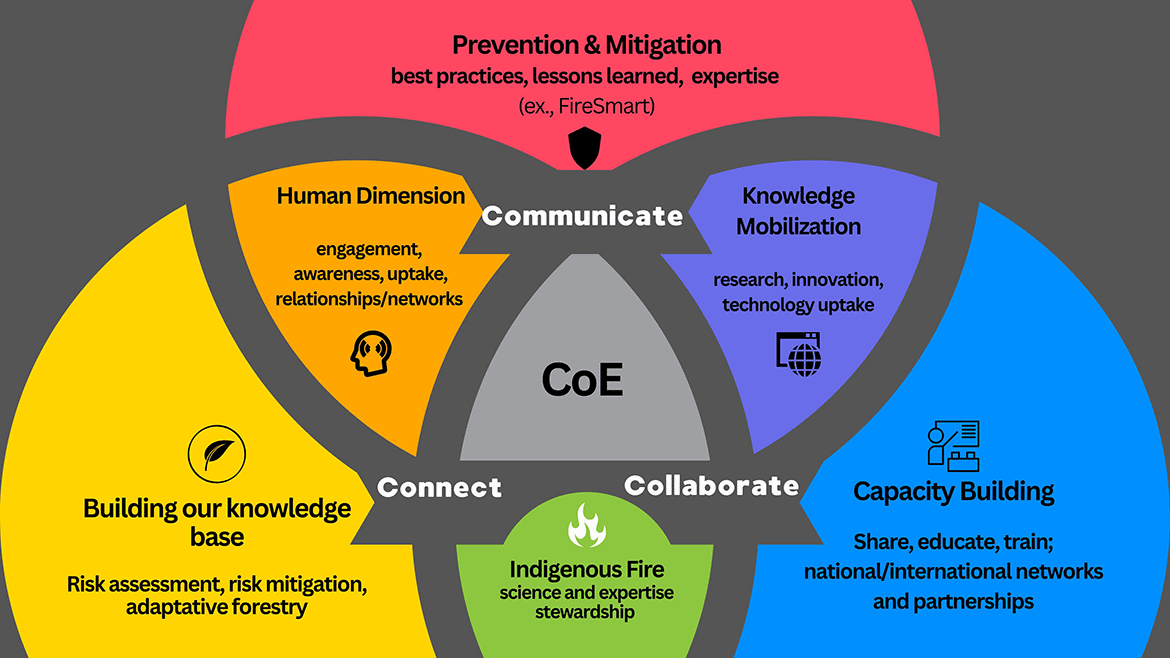The third pillar of work to be delivered through the Wildfire Resilient Futures Initiative (WRFI) is a virtual Centre of Excellence for Wildland Fire Innovation and Resilience (CoE). The CoE will gather and share the abundance of Canadian knowledge and expertise on wildland fire.
Funding opportunity - Closed
The Call for Applications is closed.
Natural Resources Canada (NRCan) will invest $11.75 million to establish the CoE over four years, starting in fiscal year 2024-25, ending March 2028. NRCan will provide funding through a contribution agreement with an organization (or partnership of organizations) that demonstrates the capacity to deliver an effective CoE that meets the goals of this initiative.
Purpose of the Centre of Excellence (CoE)
As the challenge of managing fire in various landscapes increases worldwide, the CoE will utilize Canadian knowledge and experience to:
- promote activities
- share best practices
- develop approaches that increase wildland fire resilience
Based on years of analysis and stakeholder engagement, the Canadian Forest Service has identified specific knowledge gaps related to wildland fire preparedness in Canada. This new centralized virtual location for Canadian expertise in wildland fire will enable Canada to provide leadership to the international community. The CoE will provide a means of fostering, creating and mobilizing knowledge for wildland fire innovation and resilience.
About the Centre
The CoE will be designed as a hub for facilitating research, providing information, gathering best practices, and fostering connections between people and organizations to share knowledge, insights and opportunities. The program delivery is based on three core pillars:
- educate and mobilize knowledge
- accelerate the uptake of innovation and technology
- support Indigenous fire stewardship and cultural fire use
The CoE aims to provide a forum for national and international individuals and organizations to connect, collaborate and communicate. An effective virtual presence will:
- encourage information sharing
- promote decision-making tools
- create knowledge exchange opportunities
- provide training for new innovations and technology
At the same time, it will empower communities, stakeholders and Indigenous groups in wildland fire management. The CoE’s reach and impact will extend beyond Canadian borders, fostering national and international collaboration to confront the global challenge of wildland fires.
The following diagram illustrates the role and functions of the CoE with a focus on communication and collaboration. It includes components of the WRFI, topics regarding knowledge exchange mobilization, and broad scale program objectives and activities.

Text version
The Venn diagram comprises three overlapping circles, each representing distinct concepts around the Centre of Excellence. Encircling the diagram are the themes: Communicate, Collaborate, and Connect. Here's a detailed breakdown of each circle and the intersections:
- Circle A (top)
- Prevention and Mitigation:
- This circle focuses on best practices, lessons learned, and expertise in prevention and mitigation strategies.
- Example: FireSmart initiatives.
- Prevention and Mitigation:
- Circle B (right)
- Capacity Building:
- This circle highlights sharing, educating, and training efforts, along with establishing national/international networks and partnerships.
- Capacity Building:
- Circle C (left)
- Building Our Knowledge Base:
- This circle encompasses activities related to risk assessment, risk mitigation, and adaptive forestry practices.
- Building Our Knowledge Base:
- Intersection Areas
- Between Circle A and Circle B (Knowledge Mobilization):
- This overlapping area represents the concept of knowledge mobilization.
- It includes research, innovation, and technology uptake, relevant to both Prevention and Mitigation and Capacity Building.
- Between Circle B and Circle C (Indigenous Fire):
- This overlapping area signifies Indigenous Fire.
- It includes science and expertise stewardship pertinent to both Capacity Building and Building Our Knowledge Base.
- Between Circle C and Circle A (Human Dimension):
- This overlapping area denotes the Human Dimension.
- It includes engagement, awareness, uptake, relationships and networks with regard to both Building Our Knowledge Base and Prevention and Mitigation.
- Between Circle A and Circle B (Knowledge Mobilization):
This Venn diagram visually depicts how each concept interrelates and contributes to the overarching goal of the Centre of Excellence, emphasizing the interconnectedness of prevention, capacity building, and knowledge development.
Contact us
If you have any other questions or comments, email the Wildfire Program team.